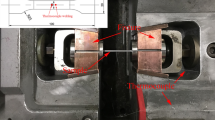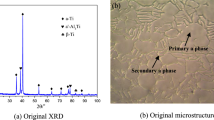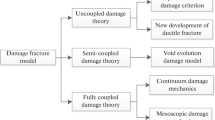Abstract
Establishing a unified constitutive model to simulate the hot deformation behaviors, microstructure evolution and fracture behaviors under different stress states during the hot forming of titanium alloy is indispensable. The high temperature tensile tests were first carried out on different stress states of forged Ti-6Al-4 V alloy specimens to analyze the flow behaviors, microstructure evolution and fracture mechanism. The results show that the effect of temperature on fracture elongation is more significant than strain rate. High temperature and low strain rate will increase the dynamic recrystallization (DRX) volume fraction and softening effect, which inhibits the nucleation and growth of voids, thereby enhancing the plastic deformation ability of the alloy. The DRX volume fraction, grain size and stress triaxiality were introduced into the unified Gurson-Tvergaard-Needleman (GTN) damage model using the internal state variables. The parameters of GTN model were modified by the Response Surface Method (RSM) and compared with the high temperature tension. Finally, the established GTN damage model was successfully applied to finite element (FE) simulation under different stress states. The correlation coefficient R of predicted stress is 0.989, and the maximum errors of DRX volume fraction and grain size are 9.86% and 6.54%. The research results can provide a basis for the performance control in hot working of titanium alloy.















Similar content being viewed by others
Data availability
The datasets generated during and/or analyzed during the current study are available from the corresponding author on reasonable request.
References
Alexander J, Stefan E, Aude P, Siller I, Helmut C (2022) In-situ high-temperature EBSD characterization during a solution heat treatment of hot-rolled Ti-6Al-4V. Mater Charact 192:112207. https://doi.org/10.1016/j.matchar.2022.112207
José DB, Wang Q, Simonetto E, Ghiotti A, Bruschi S (2021) Formability prediction of Ti6Al4V titanium alloy sheet deformed at room temperature and 600°C. Int J Mater Form 14:391–405. https://doi.org/10.1007/s12289-020-01546-z
Zhao QY, Sun QY, Xin SW, Chen YN, Wu C, Wang H, Xu JW, Wan MP, Zeng WD, Zhao YQ (2022) High-strength titanium alloys for aerospace engineering applications: a review on melting-forging process. Mater Sci Eng A 845:143260. https://doi.org/10.1016/j.msea.2022.143260
Liu SH, Pan QL, Li H, Huang ZQ, Li K, He X, Li XY (2019) Characterization of hot deformation behavior and constitutive modeling of Al–Mg–Si–Mn–Cr alloy. J Mater Sci 54:4366–4383. https://doi.org/10.1007/s10853-018-3116-4
Zhu CX, Xu J, Yu HP, Shan DB, Guo B (2022) Hybrid forming process combining electromagnetic and quasi-static forming of ultra-thin titanium sheets: formability and mechanism. Int J Mach Tool Manu 180:103929. https://doi.org/10.1016/j.ijmachtools.2022.103929
Li FQ, Mo JH, Li JL, Huang L, Zhou HY (2013) Formability of Ti–6Al–4V titanium alloy sheet in magnetic pulse bulging. Mater Des 52:337–344. https://doi.org/10.1016/j.matdes.2013.05.064
Guo J, Zhan M, Wang YY, Gao PF (2018) Unified modeling of work hardening and flow softening in two-phase titanium alloys considering microstructure evolution in thermomechanical processes. J Alloy Compd 767:34–45. https://doi.org/10.1016/j.jallcom.2018.07.079
Reddi D, Areej VK, Keralavarma SM (2019) Ductile failure simulations using a multi-surface coupled damage-plasticity model. Int J Plasticity 118:190–214. https://doi.org/10.1016/j.ijplas.2019.02.007
Acharyya S, Dhar S (2008) A complete GTN model for prediction of ductile failure of pipe. J Mater Sci 43:1897–1909. https://doi.org/10.1007/s10853-007-2369-0
Ozturk F, Lee D (2004) Analysis of forming limits using ductile fracture criteria. J Mater Process Tech 147:397–404. https://doi.org/10.1016/j.jmatprotec.2004.01.014
Xue L (2008) Constitutive modeling of void shearing effect in ductile fracture of porous materials. Eng Fract Mech 75:3343–3366. https://doi.org/10.1016/j.engfracmech.2007.07.022
Ji HC, Ma Z, Huang XM, Xiao WC, Wang BY (2022) Damage evolution of 7075 aluminum alloy basing the Gurson Tvergaard Needleman model under high temperature conditions. J Mater Res Technol 16:398–415. https://doi.org/10.1016/j.jmrt.2021.11.153
Teng BG, Wang WN, Xu YC (2017) Ductile fracture prediction in aluminum alloy 5A06 sheet forming based on GTN damage model. Eng Fract Mech 186:242–254. https://doi.org/10.1016/j.engfracmech.2017.10.014
Kumar S, Narayanan TSNS, Raman SGS, Seshadri SK (2010) Thermal oxidation of Ti6Al4V alloy: Microstructural and electrochemical characterization. Mater Chem Phys 119:337–346. https://doi.org/10.1016/j.matchemphys.2009.09.007
Gao X, Zhang N, Zhang Y et al (2022) Exploring the heat treatment parameters, microstructural evolution, and mechanical properties of Ti–6Al–4V alloy fabricated by a selective laser melting process. Met Mater Int 28:2596–2612. https://doi.org/10.1007/s12540-022-01170-3
Mohr D, Marcadet S (2015) Micromechanically-motivated phenomenological Hosford-Coulomb model for predicting ductile fracture initiation at low stress triaxialities. Int J Solids Struct 67–68:40–55. https://doi.org/10.1016/j.ijsolstr.2015.02.024
Lou YS, Wu PF, Zhang C, Wang JZ, Liu XY, Chai RG (2022) A stress-based shear fracture criterion considering the effect of stress triaxiality and lode parameter. Int J Solids Struct 256:111993. https://doi.org/10.1016/j.ijsolstr.2022.111993
Ozturk F, Ece RE, Polat N, Koksal A, Evis Z (2016) Application of electric resistance heating method on titanium hot forming at industrial scale. Arab J Sci Eng 41:4441–4448. https://doi.org/10.1007/s13369-016-2159-6
Tabassam Y, Salaheddin R, Christopher H, Zhang C, Jiang J (2022) Unravelling thermal-mechanical effects on microstructure evolution under superplastic forming conditions in a near alpha titanium alloy. J Mater Res Technol 18:4285–4302. https://doi.org/10.1016/j.jmrt.2022.04.063
Peng XN, Guo HZ, Shi ZF, Qin C, Zhao ZL, Yao ZK (2014) Study on the hot deformation behavior of TC4-DT alloy with equiaxed α + β starting structure based on processing map. Mat Sci Eng A 605:80–88. https://doi.org/10.1016/j.msea.2014.03.047
Lin P, Sun Y, Zhang S, Wang C, Chi C (2015) Microstructure and texture heterogeneity of a hot-rolled Near-α Titanium Alloy sheet. Mater Charact 104:10–15. https://doi.org/10.1016/j.matchar.2015.03.026
Ji H, Peng Z, Huang X, Wang BY, Xiao WC, Wang SF (2021) Characterization of the microstructures and dynamic recrystallization behavior of Ti-6Al-4V Titanium Alloy through experiments and simulations. J of Materi Eng and Perform 30:8257–8275. https://doi.org/10.1007/s11665-021-06044-0
Wojtas D, Wierzbanowski K, Chulist R, Pachla W, Sztwiertnia K (2020) Microstructure-strength relationship of ultrafine-grained titanium manufactured by unconventional severe plastic deformation process. J Alloy Compd 837:155576. https://doi.org/10.1016/j.jallcom.2020
Yu YB, Yan HG, Chen JH, Xia WJ, Su B, Ding T, Li ZZ, Song M (2022) Flow behavior and dynamic transformation of bimodal TC17 titanium alloy during high strain rate hot compression. J Alloy Compd 912:165260. https://doi.org/10.1016/j.jallcom.2022.165260
Zhao ST, Zhang RP, Yu Q, Ell J, Ritchie RO, Minor AM (2021) Cryoforged nanotwinned titanium with ultrahigh strength and ductility. Science 373:1363–1368. https://doi.org/10.1126/science.abe7252
Shang XQ, Cui ZS, Fu MW (2017) Dynamic recrystallization based ductile fracture modeling in hot working of metallic materials. Int J Plasticity 95:105–122. https://doi.org/10.1016/j.ijplas.2017.04.002
Mecking H, Kocks UF (1981) Kinetics of flow and strain-Harding. Acta Metall 29:1865–1875. https://doi.org/10.1016/0001-6160(81)90112-7
Cao H, Sun Y, Zhou C, Wan Z, Yang W, Ren L, Hu L (2019) Cellular automaton simulation of dynamic recrystallization behavior in V-10Cr-5Ti alloy under hot deformation conditions. T Nonferr Metal Soc 29:98–111. https://doi.org/10.1016/S1003-6326(18)64919-2
Quan GZ, Shi RJ, Zhao J, Liu Q, Xiong W, Qiu HM (2019) Modeling of dynamic recrystallization volume fraction evolution for AlCu4SiMg alloy and its application in FEM. T Nonferr Metal Soc 29:1138–1151. https://doi.org/10.1016/S1003-6326(19)65022-3
Zhao JJ, Yi YP, He HL, Huang SQ, Mao XC, Guo WF (2021) Kinetic model for describing continuous and discontinuous dynamic recrystallization behaviors of 2195 aluminum alloy during hot deformation. Mater Charact 181:111492. https://doi.org/10.1016/j.matchar.2021
Kurtz RJ, Abe K, Chernov VM, Hoelzer DT, Matsui M (2004) Recent progress on development of vanadium alloys for fusion. J Nucl Mater 329–333. https://doi.org/10.1016/j.jnucmat.2004.04.299
Roberts W, Ahlblom B (1978) A nucleation criterion for dynamic re-crystallization during hot working. Acta Metall 26:801–813. https://doi.org/10.1016/0001-6160(78)90030-5
Luo J, Li MQ, Li X (2010) Constitutive model for high temperature deformation of titanium alloys using internal state variables. Mech Mater 42:157–165. https://doi.org/10.1016/j.mechmat.2009.10.004
Tvergaard V (1981) Influence of voids on shear band instabilities under plane strain conditions. Int J Fracture 17:389–407. https://doi.org/10.1007/BF00036191
Tvergaard V, Needleman A (1984) Analysis of the cup-cone fracture in a round tensile bar. Acta Metall 32:157–169. https://doi.org/10.1016/0001-6160(84)90213-X
Xue L (2007) Damage accumulation and fracture initiation in uncracked ductile solids subject to triaxial loading. Int J Solids Struct 44:5163–5181. https://doi.org/10.1016/j.ijsolstr.2006.12.026
Nahshon K, Hutchinson JW (2008) Modification of the gurson model for shear failure. Eur J Mech Solid 27:1–17. https://doi.org/10.1016/j.euromechsol.2007.08.002
Gao PF, Guo J, Zhan M, Lei ZN, Fun MW (2020) Microstructure and damage based constitutive modelling of hot deformation of titanium alloys. J Alloy Compd 831:154851. https://doi.org/10.1016/j.jallcom.2020.154851
Mukherjee AK (2002) An examination of the constitutive equation for elevated temperature plasticity. Mat Sci Eng A 322:1–22. https://doi.org/10.1016/S0921-5093(01)01115-7
Lin JG, Balint D (2011) Development and determination of unified viscoplastic constitutive equations for predicting microstructure evolution in hot forming processes. Int J Mech Manuf Syst 4:387–401. https://doi.org/10.1504/ijmms.2011.043078
Wu Y, Fan RL, Qin ZH, Chen MH (2021) Shape controlling and property optimization of TA32 titanium alloy thin-walled part prepared by hot forming. T Nonferr Metal Soc 31:2336–2357. https://doi.org/10.1016/S1003-6326(21)65658-3
Aravas N (1987) On the numerical integration of a class of pressure-dependent plasticity models. Int J Numer Meth Eng 24:1395–1416. https://doi.org/10.1002/nme.1620240713
Wang CC, Wei XL, Ren D, Wang X, Xu W, Mahajan KA (2022) High-throughput map design of creep life in low-alloy steels by integrating machine learning with a genetic algorithm. Mater Des 213:110326. https://doi.org/10.1016/j.matdes.2021.110326
Li S, Li S, Liu DR, Zou R, Yang ZH (2022) Hardness prediction of high entropy alloys with machine learning and material descriptors selection by improved genetic algorithm. Comp Mater Sci 205:111185. https://doi.org/10.1016/j.commatsci.2022.111185
Tvergaard V (1982) On localization ductile materials containing spherical voids. Int J Fracture 18:237–252. https://doi.org/10.1007/BF00015686
Kadam BJ, Mahajan KA (2021) Optimization of cutting temperature in machining of titanium alloy using response surface method, genetic algorithm and Taguchi method. Mater Today 47:6285–6290. https://doi.org/10.1016/j.matpr.2021.05.252
Wei K, Zhan M, Fan XG, Yang H, Gao PF, Meng M (2018) Unequal-thickness billet optimization in transitional region during isothermal local loading forming of Ti-alloy rib-web component using response surface method. Chin J Aeronaut 31:845–859. https://doi.org/10.1016/j.cja.2017.07.005
Shang XQ, Cui ZS, Fu MW (2018) A ductile fracture model considering stress state and zener–Hollomon parameter for hot deformation of metallic materials. Int J Mech Sci 144:800–812. https://doi.org/10.1016/j.ijmecsci.2018.06.030
Acknowledgements
This study was supported by the financial support from National Natural Science Foundation of China (52375345) and Aviation Engine Independent Innovation Special Foundation of China (ZZCX-2018-031).
Author information
Authors and Affiliations
Contributions
Rui Feng: Writing - original draft, Methodology, Investigation. Minghe Chen: Writing - review & editing, Supervision, Project administration. Lansheng Xie: Conceptualization.
Corresponding author
Ethics declarations
Declarations of Competing Interest . The authors declare that they have no known competing financial interests or personal relationships that could have appeared to influence the work reported in this paper.
Additional information
Publisher’s Note
Springer Nature remains neutral with regard to jurisdictional claims in published maps and institutional affiliations.
Supplementary information
Below is the link to the electronic supplementary material.
ESM 1
(DOCX 15.4 KB)
Rights and permissions
Springer Nature or its licensor (e.g. a society or other partner) holds exclusive rights to this article under a publishing agreement with the author(s) or other rightsholder(s); author self-archiving of the accepted manuscript version of this article is solely governed by the terms of such publishing agreement and applicable law.
About this article
Cite this article
Feng, R., Chen, M. & Xie, L. Unified thermomechanical model of Ti-6Al-4V titanium alloy considering microstructure evolution and damage fracture under different stress state. Int J Mater Form 17, 1 (2024). https://doi.org/10.1007/s12289-023-01799-4
Received:
Accepted:
Published:
DOI: https://doi.org/10.1007/s12289-023-01799-4




